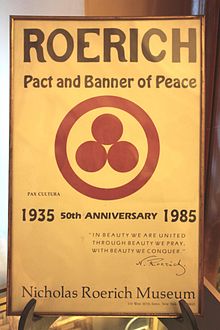Roerich Pact

The Roerich Pact is a treaty on Protection of Artistic and Scientific Institutions and Historic Monuments, signed by the representatives of 21 states in the Oval Office of the White House on 15 April 1935. As of January 1, 1990, the Roerich Pact had been ratified by ten nations: Brazil, Chile, Colombia, Cuba, the Dominican Republic, El Salvador, Guatemala, Mexico, the United States, and Venezuela. It went into effect on 26 August 1935. The government of India approved the treaty in 1948 but did not take any further formal action. The Roerich Pact is also known as Pax Cultura ("Cultural Peace" or "Peace through Culture"). The most important part of the Roerich Pact is the legal recognition that the protection of culture is always more important than any military necessity.
Nicholas Roerich
[change | change source]The Russian painter and philosopher Nicholas Roerich (1874-1947) started the modern movement for the defense of cultural objects, in order for a “Peace of Civilizations”.
Roerich was born on October 9, 1874, in St. Petersburg, Russia. He became a successful painter, and one of his paintings was purchased by Tsar Nicholas II.
After 1918, Roerich left Russia. In 1923, the Roerich Museum was founded in New York and is now in Manhattan at the corner of 107th Street and Riverside Drive. Finally, Roerich settled down in the Kulu Valley in Himachal Pradesh in the Himalayas. He died on December 13, 1947.
In 1929, Roerich, working with Paris University professor Giorge Chklaver, wrote a draft of an international treaty dedicated to protection of cultural values (Roerich Pact).[1]
US President Franklin D. Roosevelt had a decisive influence on the process of signing of the treaty by all nations of the American continent. Incidentally, Roosevelt kept in his private rooms a bust of Roerich.[2]
The Roerich Pact was the basis for the United Nations “International Convention for Protection of Cultural Values in the Event of Armed Conflict” signed in 1954. However, not all of the ideas of the Roerich Pact are fully implemented in international law, especially the preference of the preservation of cultural values over military necessity.

Chronology
[change | change source]- 1904: Nicholas Roerich proposed the idea of the protection of artistic and scientific achievements of humanity.
- 1914: Roerich proposed his idea to the Russian imperial government during World War I.
- 1929: Roerich proposed to the nations to establish a pact for the preservation of the artistic and scientific world treasures.
- 1930: The Roerich Pact was submitted to and approved by the Museums Committee of the League of Nations. The “Committee of the Roerich Banner of Peace” (New York) and the “Comité pour le Pact Roerich” (Paris) were founded.
- 1931: the “Union International pour le pact Roerich” (Bruges, Belgium) was founded. September 13—15: the First International Conference was dedicated to the promulgation of the Roerich Pact (Bruges).
- 1932: August 8-9, 1932 : theSecond International Conference of the Roerich Pact (at Bruges). “Foundation Roerich pro Pace, Arte, Scientiae et Labore” (Bruges) was founded.
- 1933: November 17-18, 1933 — the Third International Convention of the Roerich Pact and Banner of Peace (Washington, DC).
- 1935: April 15, 1935-the Treaty of the Roerich Pact signed at the White House, in Washington DC, by 21 countries of the Pan-American Union.
- 1948: the Indian government approved the Roerich Pact.
- 1954: on May 14, the UN ”International Convention for Protection of Cultural Values in the Event of Armed Conflict" was adopted in The Hague and was inspired by the Roerich Pact.
- 1956: the convention became effective on August 7.

Banner of Peace
[change | change source]The Roerich Pact proposed a flag to identify protected objects, the Banner of Peace, which was a white cloth containing a red ring and three red circles inscribed in it. The sign symbolized a unity of the past, present, and future into the ring of eternity. Ideas from the Pact were reflected in Roerich's art. The Banner of Peace symbol is shown in many of his paintings.
Importance in 21st century
[change | change source]The Roerich Pact is an international treaty, but it also contains legal ideas about a new type of state. The state budget should include money spent on culture, art and education that must be larger than military expenses. That is the legal recognition that the protection of cultural objects is more important than any military necessity. Roerich thought that caring for future generations was an important reason for constitutional states to exist.[3]
US President Franklin D. Roosevelt, in the speech upon the signature of the Roerich Pact, said, "In opening this Pact to the adherence of the Nations of the world, we are endeavoring to make of universal application one of the principles vital to the preservation of modern civilization. This Treaty possesses a spiritual significance far deeper than the text of the instrument itself."[4]
The Roerich Pact was an important step towards the future development of a new legal culture. The provisions of Roerich’s concept are based on the idea that the primary duty of the state is to preserve the national culture. The ideas of the Roerich Pact are still not fully implemented in international law.[5] Some people think that the 21st century is the time to implement his ideas.[6]
Related pages
[change | change source]References
[change | change source]- ↑ Leslie Brenner, Nicholas Roerich. Idealist and Visionary, Foreign Affairs Journal, April 1990
- ↑ Shoumatoff, Elizabeth (1990). FDR'S Unfinished Portrait: A Memoir. ISBN 978-0-8229-3659-6.
- ↑ Peter Barenboim, Naeem Sidiqi, Bruges, the Bridge between Civilizations: The 75 Anniversary of the Roerich Pact, Grid Belgium, 2010 Archived 2016-10-11 at the Wayback Machine. ISBN 978-5-98856-114-9
- ↑ Barenboim P., Sidiqi N., Op.cit. p. 79
- ↑ Peter Barenboim, Naeem Sidiqi, Op.cit. p. 98
- ↑ Lewis K. Elbinger, "The Unifying Power of Art", in Foreign Service Journal, April 1990
